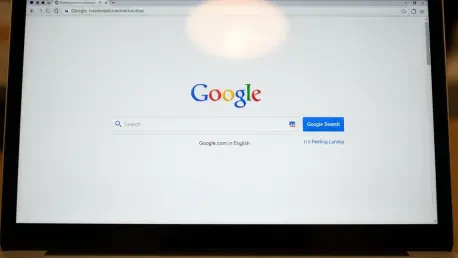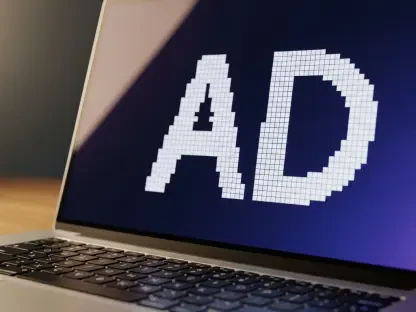Setting the Stage in Digital Advertising
The digital advertising industry, a cornerstone of the global economy, generates hundreds of billions of dollars annually, shaping how brands connect with consumers across the internet, and it’s a marketplace where every click, view, and impression is auctioned in milliseconds, yet one player often holds nearly all the cards. This is the reality that PubMatic, an innovative ad tech company, challenges in its recent lawsuit against Google, alleging monopolistic practices that stifle competition. With the stakes higher than ever, this legal battle could redefine the rules of a sector that underpins much of the online experience, drawing attention to the power dynamics at play.
This industry thrives on a complex ecosystem known as the ad tech stack, comprising tools like publisher ad servers, ad exchanges, and demand-side platforms that facilitate real-time transactions. These components work together to match advertisers with available ad spaces on websites, ensuring efficiency and relevance. As digital ad spending continues to soar, the influence of this sector on global commerce becomes undeniable, affecting everything from small publishers to multinational corporations.
The significance of open-web display advertising cannot be overstated, as it represents a primary battleground in this dispute. Unlike the walled gardens of social media platforms, the open web offers a diverse landscape where independent publishers monetize content. However, dominance by a single entity in this space raises critical questions about fairness and access, setting the stage for an intense examination of market practices through legal action.
Overview of the Digital Advertising Industry
The digital advertising sector stands as a titan in today’s economy, with revenues surpassing traditional media channels and driving innovation in technology and marketing. Its multi-billion-dollar scale reflects a shift in how businesses allocate budgets, prioritizing online channels to reach vast audiences. This growth has transformed the internet into a commercial hub, where ad impressions fuel both content creation and corporate profits.
At the heart of this industry lies the ad tech stack, a sophisticated framework that includes publisher ad servers for managing ad inventory, ad exchanges for auctioning impressions, and demand-side platforms for advertisers to bid on spaces. Real-time bidding (RTB), a groundbreaking technology pioneered by companies like PubMatic, enables instantaneous auctions, optimizing ad placement efficiency. Such advancements have redefined speed and precision in advertising, though they also highlight disparities in market control.
Major players dominate this landscape, with Google holding a commanding position through its integrated suite of ad tech tools. Competitors like PubMatic strive to carve out space by focusing on transparency and innovation, particularly in open-web display advertising. As the primary area of contention in the lawsuit, this segment underscores the broader struggle for a balanced market where smaller entities can thrive alongside giants.
Background and Context of PubMatic’s Lawsuit Against Google
Genesis of the Legal Action
On September 8 of this year, PubMatic filed a significant antitrust lawsuit against Google in the U.S. District Court for the Eastern District of Virginia, under Case No. 1:25-cv-1482. The complaint accuses Google of leveraging monopolistic practices to dominate publisher ad server and ad exchange markets, effectively sidelining competitors. This legal move marks a pivotal moment in challenging the status quo of digital ad distribution.
PubMatic’s allegations center on Google’s systematic efforts to control critical components of the ad tech ecosystem, allegedly harming competition over more than a decade. These actions, the company claims, have not only limited its own growth but also reshaped the industry to favor one entity. Such claims point to a deeper issue of market access and fairness that could have lasting repercussions.
Founded in 2006, PubMatic has been at the forefront of ad tech innovation, notably introducing real-time bidding that transformed how ad transactions occur. Despite its contributions, the company asserts that Google’s tactics have undermined its ability to compete on equal footing. This historical context of innovation versus dominance forms the backbone of the legal challenge now unfolding.
Legal Precedents and Industry Consensus
A federal court ruling on April 17 of this year by Judge Leonie Brinkema found Google guilty of illegally monopolizing ad tech markets, setting a crucial precedent for PubMatic’s case. This decision validated long-standing concerns about anticompetitive behavior, providing a legal foundation for subsequent actions. It represents a turning point in how judicial oversight addresses tech dominance.
The Department of Justice initiated an antitrust lawsuit against Google in January 2023, paving the way for private companies to follow suit with their grievances. This governmental action underscored systemic issues within the industry, encouraging firms to seek redress. PubMatic’s lawsuit is thus part of a broader wave of accountability efforts targeting entrenched power structures.
Additional lawsuits from companies like OpenX and Dotdash Meredith reflect a growing industry consensus that Google’s practices warrant scrutiny and reform. These collective legal challenges highlight a unified front against perceived monopolistic behavior, suggesting that change may be on the horizon. The momentum of these actions could reshape competitive dynamics in meaningful ways.
Challenges Posed by Google’s Alleged Monopolistic Practices
PubMatic’s detailed 85-page complaint outlines specific anticompetitive tactics employed by Google, including the 2008 acquisition of DoubleClick for $3.1 billion, which allegedly aimed to bolster control over ad servers and exchanges. Policies like “First Look” and “Last Look” are cited as mechanisms that gave Google’s Ad Exchange unfair advantages in auctions. These strategies reportedly ensured preferential access to impressions, sidelining competitors.
Further accusations point to technical manipulations such as the “Sell-Side Dynamic Revenue Share” and “Project Poirot,” which allegedly rigged auction outcomes to favor Google’s platforms. Such practices are said to have distorted fair bidding processes, reducing revenues for independent exchanges like PubMatic. The complaint paints a picture of a market deliberately tilted against smaller players.
The lack of transparency from Google, including deceptive communications about performance declines, is another critical issue raised. This opacity has eroded trust among industry stakeholders, making it difficult for competitors to respond to hidden disadvantages. Financially, PubMatic reports severe impacts, including revenue drops and workforce cuts, alongside broader harms like diminished publisher earnings and elevated advertising costs across the sector.
Regulatory Landscape and Antitrust Scrutiny in Ad Tech
Increasing legal and regulatory attention on Google’s dominance in digital advertising has intensified with the Department of Justice lawsuit and recent court rulings. These efforts signal a shift toward stricter oversight of tech giants, aiming to curb practices that hinder competition. The focus on antitrust law seeks to address systemic imbalances within the market.
PubMatic’s lawsuit leverages this momentum, requesting trebled damages and injunctive relief to halt Google’s alleged anticompetitive conduct. Such remedies aim not only to compensate for past losses but also to enforce future compliance with fair market principles. Judicial findings are pushing for greater accountability, potentially altering how ad tech operates.
The evolving regulatory landscape suggests that transparency and compliance standards could tighten in response to these challenges. As courts and regulators scrutinize monopolistic behavior, the industry may see reforms that prioritize equitable access to technology and data. This shift holds promise for leveling the playing field if sustained over the coming years.
Future Outlook for Digital Advertising Amid Legal Battles
The outcome of PubMatic’s lawsuit could significantly influence Google’s practices, potentially forcing a reevaluation of auction mechanisms and market access policies. A favorable ruling for PubMatic might compel structural changes, reducing barriers for competitors. This legal battle’s resolution will likely serve as a benchmark for future disputes in the sector.
Emerging trends, such as the adoption of alternative technologies like header bidding, offer hope for countering monopoly power by empowering publishers with more control over ad sales. These innovations could diversify the market if supported by regulatory outcomes that limit exclusionary tactics. The push for such tools reflects an industry eager for balance.
Looking ahead, market disruptors and new technologies may foster competition if Google’s alleged practices are curtailed. Combined with shifting consumer expectations for transparency and global economic factors, the digital advertising landscape could evolve toward greater fairness. From this year to 2027, these dynamics will likely shape a critical period of transformation and opportunity.
Reflecting on the Findings
Looking back, the legal confrontation between PubMatic and Google illuminated deep-seated issues within the digital advertising realm, where monopolistic practices were seen to have suppressed competition and innovation. The detailed allegations of strategic acquisitions and auction manipulations underscored a market struggling under the weight of dominance. Financial and competitive harms suffered by PubMatic mirrored broader industry challenges that demanded resolution.
As a path forward, stakeholders were encouraged to advocate for robust antitrust enforcement and embrace alternative technologies that enhance publisher autonomy. Collaborative efforts between regulators, companies, and industry bodies appeared vital to dismantle exclusionary barriers and promote transparency. Investing in innovation and supporting smaller players became essential steps to ensure a vibrant, competitive ecosystem in the years that followed.









